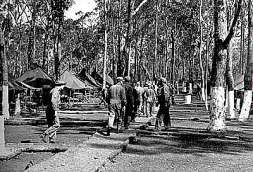Camp Strathpine
From July 1943 until February 1944, 15,000 servicemen attached to the 1st Cavalry Division, United States Army, camped in an extensive area to the west of Strathpine. The Divisional camp, generically referred to as Camp Strathpine, stretched from Kremzow Road, Warner, to the North Pine River at Youngs Crossing, then north-east across Dayboro Road into what is now the Frenchs Forest estate in Petrie.
Although the 1st Cavalry Division had traditionally been a mounted unit with its origins extending back to the early years of the American frontier, the changing nature of modern warfare dictated the need for a sudden transition to a dismounted unit utilising tanks, jeeps, gun carriers, etc. Following manoeuvres and training in the south-west of the United States, the men of the 1st Cavalry Division, under the command of Major General Innis P. Swift, departed from their home base at Fort Bliss, Texas, in mid June 1943. On 3 July, they left Camp Stoneman in California and headed towards the South Pacific aboard the troopships George Washington and Monterey. After a three week voyage, they landed in Brisbane on 26 July and boarded trucks for the short journey to their new home at Strathpine.

Camp Strathpine, constructed by the troopers with assistance from Australian workmen, quickly became a showcase military facility. Although a large number of huts were constructed for use as storage sheds, kitchens, mess halls, recreation huts, etc., the majority of the men were accommodated under canvas in tented areas joined by gravel pathways. For administrative purposes, Camp Strathpine was divided into six main areas and the Divisional Headquarters area, identified as Area 1, was established in bushland west of One Mile Creek, near what is now Ribblesdale Court, off Forgan Road, Joyner.
Although the Pine Rivers region bore few similarities to the desert terrain of the American south-west, it soon gave the troopers a strong sense of the skills and stealth required for jungle fighting. At Camp Strathpine, a strong emphasis was placed on continued intensive battle training to reinforce the transition to an unmounted unit. A Divisional reorganisation also facilitated the change to a new style of warfare involving the use of heavy artillery and bombardment rather than the traditional charge of the infantry. The Division's artillery units carried out live firing on a range near Clear Mountain and there were several mortar and grenade ranges located in Cashmere. Amphibious training with repeated beach landings took place at Port Stephens (New South Wales) and at nearby Moreton Bay. All through this period, a steady stream of official visitors came to inspect the activities of the soldiers and the facilities at Camp Strathpine.
Beginning in December 1943 and extending into early 1944, sections of the 1st Cavalry Division progressively left Australian shores to reassemble at Oro Bay in New Guinea. The Division subsequently took part in many actions in New Guinea and the Philippines before the end of the Pacific War. Several of the Division's Regiments also remained on active service in Japan throughout 1946. Following the deployment of the Americans to the frontline, Camp Strathpine was used by various units of the Australian 7th Division (2nd A.I.F.) before they, too, were posted northwards. After the end of World War 2, most of the buildings were sold at auction for removal and, today, little tangible evidence remains to indicate the former existence of the large camp.
